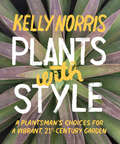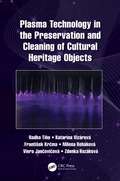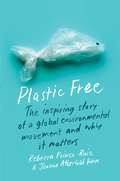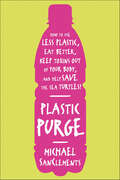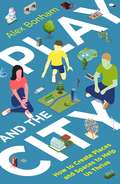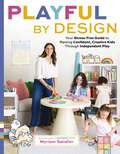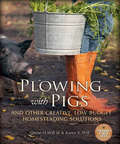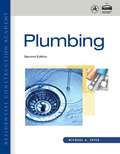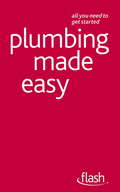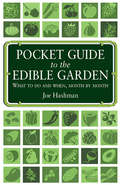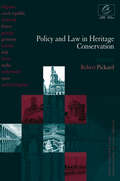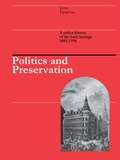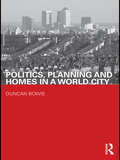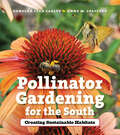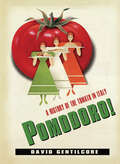- Table View
- List View
Plants with Style: A Plantsman's Choices for a Vibrant, 21st-Century Garden
by Kelly Norris“A love letter to plants…that oozes enthusiasm.” —The English Garden Why settle for lackluster gardens filled with dull, ho-hum plants? In this spirited, provocative book, plant guru Kelly Norris calls for a garden revolution: out with the boring plants and in with the exciting newcomers that will make your jaw drop and your pulse quicken! A passionate horticulturist and lifelong gardener, Kelly is the ideal guide to the botanical riches available to today’s gardeners. In chapters on environment, structure, seasonal standouts, and plant combinations he shines a spotlight on the A-list plants in every category—plants that will thrive, not merely survive. Along the way, he shows you how to forge a personal style in harmony with your garden’s setting and local environment. As Kelly puts it, “A garden is the best way to savor life on earth.” Let Plants with Style guide you to the plants that will provide a richer, more fulfilling connection between you and your own patch of soil.
Plasma Technology in the Preservation and Cleaning of Cultural Heritage Objects
by Radko Tiňo Katarína Vizárová František Krčma Milena Reháková Viera Jančovičová Zdenka KozákováScientists have long been looking for alternative methods for the cleaning of historical and cultural museum objects as conventional methods often fail to completely remove surface films, leaving contamination and surface residues behind. Low-temperature plasmas have recently been found to provide a new, efficient and durable approach that maintains the safety of both the materials and personnel. This book is the first to introduce the emerging use of low-temperature plasmas in the cleaning and decontamination of cultural heritage items. It provides a comprehensive exploration of the new possibilities of cleaning objects with plasma, before providing a practice guide to the individual cleaning methods and an overview of the technologies and conditions used in the different cleaning regimes. It is an ideal reference for researchers in plasma physics, in addition to professionals working in the field of historical and cultural conservation. Features: Provides a thorough overview of the cleaning potential of emerging plasma technologies in accessible language for professional restorers and conservators without a scientific background Includes the latest case studies from the field, which have not been published elsewhere yet Authored by a team of experts in the field
Plastic Free: The Inspiring Story of a Global Environmental Movement and Why It Matters
by Joanna Atherfold Finn Rebecca Prince-RuizIn July 2011, Rebecca Prince-Ruiz challenged herself to go plastic free for the whole month. Starting with a small group of people in the city of Perth, the Plastic Free July movement has grown into a 250-million strong community across 177 countries, empowering people to reduce single-use plastic consumption and create a cleaner future.This book explores how one of the world’s leading environmental campaigns took off and shares lessons from its success. From narrating marine-debris research expeditions to tracking what actually happens to our waste to sharing insights from behavioral research, it speaks to the massive scale of the plastic waste problem and how we can tackle it together. Interweaving interviews from participants, activists, and experts, Plastic Free tells the inspiring story of how ordinary people have created change in their homes, communities, workplaces, schools, businesses, and beyond.It is easy to feel overwhelmed in the face of global environmental problems and wonder what difference our own actions could possibly make. Plastic Free offers hope for the future through the stories of those who have taken on what looked like an insurmountable challenge and succeeded in innovative and practical ways, one step—and one piece of plastic—at a time.
Plastic Purge: How to Use Less Plastic, Eat Better, Keep Toxins Out of Your Body, and Help Save the Sea Turtles!
by Michael SanClementsNow a Denver Post #1 bestseller. Plastic is everywhere we look. Our computers and children's toys are made out of it, and our water and slices of American cheese are packaged in it. But why is there so much and what is it doing to our bodies? Is it possible to use less plastic and be happier and healthier?In Plastic Purge, ecologist, SanClements has put together the most up-to-date and scientifically-backed information available to explain how plastics release toxins into your body and the effect they have on your and your children's health. Both approachable and engaging, Plastic Purge provides easy-to-follow advice for how to use less plastic, thereby reaping the benefits such as eating a healthier diet and living with less clutter. Dividing plastics into three separate categories: the good, the bad, and the ugly, SanClements shows you how to embrace the good (items like your phone or medical equipment), avoid the bad (food storage containers and toys that contain toxic chemicals), and use less of the ugly (single-use plastic that's just plain wasteful).With the help of Michael SanClements's Plastic Purge, you and your family will develop easy habits to live a healthier and happier lives.
Plastic-Free
by Beth TerryLike many people, Beth Terry didn't think an individual could have much impact on the environment. But while laid up after surgery, she read an article about the staggering amount of plastic polluting the oceans and decided then and there to kick her plastic habit. Now she wants to teach you how you can too. In her quirky and humorous style--well known to the readers of her popular blog, My Plastic-Free Life--Terry provides personal anecdotes, stats about the environmental and health problems related to plastic, and personal solutions and tips on how to limit your plastic footprint. Terry includes handy lists and charts for easy reference, ways to get involved in larger community actions, and profiles of individuals-- Plastic-Free Heroes--who have gone beyond personal solutions to create a change on a larger scale. Plastic-Free also includes chapters on letting go of eco-guilt, strategies for coping with overwhelming problems, and ways to relate to other people who aren't as far along on the plastic-free path. Both a practical guide and the story of a personal journey from helplessness to empowerment, Plastic-Free is a must-read for anyone concerned about the ongoing health and happiness of themselves, their children, and the planet.
Plastics and Industrial Design (John Gloag On Industrial Design Ser.)
by John GloagOriginally published in 1945, Plastics and Industrial Design is a non-technical work of reference for manufacturers and designers who, after the Second World War were beginning to realize the possibilities that manufacturing with Plastics could bring. The different types of plastics and their uses is discussed, as is their impact on the design of manufactured articles. Whilst the extensive use of plastic may have fallen out of favour in recent years due to environmental concerns, this book reminds us that in their infancy they offered exciting manufacturing possibilities.
Play and the City: How to Create Places and Spaces To Help Us Thrive
by Alex BonhamPlay is essential, for children but also adults. It's how we relax and revitalise ourselves, build and maintain friendships, try new things, learn and innovate.Cities have always been sites of play, bringing people together and pushing the boundaries of what is humanly possible. And now we need our cities to encourage and facilitate play of all kinds more than ever. If we want a world for our children to play in, we need to have a go at doing things differently. A city that is enjoyable to live in - that provides welcoming spaces, plentiful resources, and an attitude of 'yes, you can' - is a playful city. A city that is good for eight-year-olds as well as eighty-year-olds is a city that's good for all of us. By looking at how different cities across space and time have sought to encourage and facilitate play, Bonham shows us how to conceptualise our own contemporary city as a game, and encourages us to become participants rather than spectators.Play the city! Get involved, make a difference and help to bring your city back to life. There is help here to identify opportunities, build a team of friends and allies, take part - and win! It's time to make your move.
Play and the City: How to Create Places and Spaces To Help Us Thrive
by Alex BonhamPlay is essential, for children but also adults. It's how we relax and revitalise ourselves, build and maintain friendships, try new things, learn and innovate.Cities have always been sites of play, bringing people together and pushing the boundaries of what is humanly possible. And now we need our cities to encourage and facilitate play of all kinds more than ever. If we want a world for our children to play in, we need to have a go at doing things differently. A city that is enjoyable to live in - that provides welcoming spaces, plentiful resources, and an attitude of 'yes, you can' - is a playful city. A city that is good for eight-year-olds as well as eighty-year-olds is a city that's good for all of us. By looking at how different cities across space and time have sought to encourage and facilitate play, Bonham shows us how to conceptualise our own contemporary city as a game, and encourages us to become participants rather than spectators.Play the city! Get involved, make a difference and help to bring your city back to life. There is help here to identify opportunities, build a team of friends and allies, take part - and win! It's time to make your move.
Play in Creative Problem-solving for Planners and Architects
by Ron KasprisinIn Play in Creative Problem-solving for Planners and Architects, "play" is defined, explored and demonstrated as a critical catalyst in creative problem-solving processes. The book defines the current psychological research into play and creative problem-solving, explores the necessary integration of the two, and exemplifies for students and practitioners the use of play in creative endeavors; and the role that play serves in separating linear from creative problem-solving approaches. Play is explored regarding its elements (tools, skills, environment), characteristics (a free activity without failure) and attitude as it relates to and activates the creative process with the focus on urban design, planning, architecture, and landscape architecture. The book re-establishes the whole mind-body thinking process of play as a means of object-learning; to provide designers and planners with alternative ways of design-thinking; and to challenge the over-utilization of digital technologies in creative processes. Creative problem-solving requires an appreciation for ambiguity, uncertainty of outcome, complexity that leads to the discovery of novelty and innovation. The book incorporates examples and exercises in play activities related to the design and planning fields, and exercises related to play-tools and skills for students and professionals. It also defines terms used in play and creativity psychology; provides examples and structure for play and creative problem-solving activities; describes the type and use of appropriate play-tools; contains an extensive bibliography on play and creative problem-solving texts; and provides significant illustrations making it fundamental reading for students and professionals in urban design and planning fields.
Playful by Design: Your Stress-Free Guide to Raising Confident, Creative Kids through Independent Play
by Myriam SandlerHelp your kids grow into confident, creative, and independent little people by creating spaces in your home that foster independent play.Myriam Sandler, creator and founder of Mothercould, helps you give your kids the tools they need to unlock their imaginations and encourage kid-directed, kid-executed, and ultimately kid-enriching independent play using the materials and spaces you already have. Not only will this system help your children grow, it will also help foster a more connected, more productive, and happier home for your entire family.Through colorful photography and vibrant illustration Playful by Design is your blueprint for effortlessly designing, installing, and maintaining your own upgraded play spaces. Myriam Sandler has created a resource to help you—easily and affordably—create spaces for independent play, no matter how big or small your home is.Myriam shares activities that:Build problem-solving skillsEncourage social and academic developmentEngage children while building moments of play and connectionNurture independence and self-expressionHelp work through emotions, andOffer parents important parenting wins that benefit the entire family As your kids engage with self-directed, open-ended play, you'll realize what a game-changer this new dynamic is for the entire household. For the parents, there's no more feeling overwhelmed and stretched thin by unrealistic expectations about how to entertain your kids. And for your kids, you're giving them the most beautiful gift: the ability to be independent self-starters who are in touch with their own creativity. In short: everyone will feel happier, more energized, more fulfilled, and more connected.Myriam will help you:Plan the spaceDeclutterOrganize by type (and customize for various age groups!)Set up a toy rotation systemMaintain (easily and efficiently!) In addition to the how, Myriam explains the why. This beautifully designed book will equip you to understand the importance of independent play, as well as set it into motion. You'll discover that boredom can be a good thing, and you'll see how it can make their imaginations blossom. This type of play creates more time for your kids to grow as creative and independent little people; more time for you to do the things you need and want to do; more peace of mind that you are, in fact, giving your kids important tools they'll thank you for one day; and more opportunities to feel the joy of all of the above.
Please Grow: Lessons on Thriving for Plants (and People)
by Alex TestereDiscover the life lessons plants can teach you—from the importance of putting down roots to leaning on others for support and nourishment—in this charming, illustrated guide to personal growth.Every idea, relationship, or project begins with a seed: A seed of creativity, a flicker of hope, an inkling of motivation. In Please Grow, illustrator Alex Testere takes us on a journey through the life of a well-tended plant or garden—from nourishing a seed to propagating, protecting, pruning, and beyond—relating the lessons we can learn from the natural world to our everyday lives, including:Planting a seed is only the beginning.A flower is a reminder of what is possible when the right circumstances align.Extending your roots is like building community--both are lifelines.Compost old ideas and experiences to create fuel for a fresh start.Nothing lasts forever--and in some cases, that can be a good thing.With sweet, vibrant art, ecological sidebars, and a sprinkling of practical plant care tips, Please Grow is a gentle reminder of life's cyclical, ever-blossoming nature. We all have the power to plant our own seeds and harvest our own blooms. So, what are you waiting for?
Plowing with Pigs and Other Creative, Low-Budget Homesteading Solutions
by Karen K. Will Oscar H. WillFueled by a failing economy and a passionate desire for a return to simpler times, a new wave of homesteaders is seeking the good life and the kind of true satisfaction that can only be built, not bought. Many of these modern pioneers are cash poor, but rich in energy and creativity. Plowing with Pigs and Other Creative, Low-Budget Homesteading Solutions offers them a set of fresh ideas for achieving independence through sweat equity and the use of unconventional resources. This highly readable and entertaining guide brings together answers to common problems faced by homesteaders young and old, urban, suburban, and rural. Traditional knowledge is combined with MacGyver-style ingenuity to create projects that maximize available resources, including: Animal management strategies for the yard, garden, and field Pole building and construction techniques from woodlot materials Replacing farm machinery with homemade hand tools and implements Leveraging increased self-sufficiency into a home-based business Whether you are a dreamer or a doer, Plowing with Pigs will inspire, challenge, and enable you to do more with less (and have fun doing it). Oscar H. (Hank) Will III is a farmer, scientist, and author, known for seeking and implementing creative farmstead solutions. The editor of Grit magazine, Hank has published hundreds of articles and five books on a range of topics including antique farm machinery. Karen K. Will is editor of The Heirloom Gardener magazine and author of Cooking with Heirlooms: Seasonal Recipes with Heritage-Variety Vegetables and Fruits. She operates Prairie Turnip Farm with her husband Oscar H. Will III.
Plumbing
by Michael A. JoyceRESIDENTIAL CONSTRUCTION ACADEMY: PLUMBING, 2E is the ideal book to create a direct link between readers' education/training program and the residential construction industry. The result of a strategic partnership between the National Association of Home Builder's (NAHB) Home Builders Institute and Delmar, Cengage Learning, the Residential Construction Academy Series is the perfect way to learn essential workplace skills for readers new to the building trades. Written in partnership with the Home Builders Institute, and endorsed by NAHB, RESIDENTIAL CONSTRUCTION ACADEMY: PLUMBING, 2E provides a step-by-step approach to residential plumbing installations based on national skill standards. Focusing on "Green" advancement in the plumbing trades, this book thoroughly explains the process of installing residential plumbing systems by exploring topics such as tools of the trade and proper safety measures and by offering various tips to increase readers' on-the-job productivity. Logically organized to build a foundation of knowledge, this book progresses from the installation of common fixtures to troubleshooting techniques that will aid readers. An emphasis on creative layout and the importance of understanding code variations will foster readers' understanding of plumbing system installation that is based on typical situations as well as unique jobsite conditions.
Plumbing Made Easy: Flash
by Roy TreloarThe books in this bite-sized new series contain no complicated techniques or tricky materials, making them ideal for the busy, the time-pressured or the merely curious. Plumbing Made Easy is a short, simple and easy to follow guide to mastering some simple plumbing jobs that might occur on an everyday basis. By learning some basic skills and techniques you can learn how to carry out repairs and simple projects - in just 96 pages. Ideal for the busy or the thrifty, Plumbing Made Easy is a quick, to-the-point guide for those who want to complete simple plumbing jobs quickest time possible.
Plumbing Made Easy: Flash
by Roy TreloarThe books in this bite-sized new series contain no complicated techniques or tricky materials, making them ideal for the busy, the time-pressured or the merely curious. Plumbing Made Easy is a short, simple and easy to follow guide to mastering some simple plumbing jobs that might occur on an everyday basis. By learning some basic skills and techniques you can learn how to carry out repairs and simple projects - in just 96 pages. Ideal for the busy or the thrifty, Plumbing Made Easy is a quick, to-the-point guide for those who want to complete simple plumbing jobs quickest time possible.
PlyDesign: 73 Distinctive DIY Projects in Plywood (and other sheet goods)
by Philip SchmidtMake sleek and functional home furnishings from inexpensive plywood and other off-the-shelf materials using only basic hand and power tools. This unique building guide offers 73 innovative ideas for using plywood to make everything from desks and workstations to children’s playhouses. Projects for every need and skill level are presented with clear assembly diagrams, step-by-step instructions, and photos of the finished product. Discover the simplistic beauty plywood can bring to your next project and take pride in making your own handmade furniture.
Pocket Guide To The Edible Garden: What To Do And When, Month By Month
by Joe HashmanThe Pocket Guide to the Edible Garden takes its readers through the fruit and vegetable gardening year, listing month-by-month the tasks to be done and showing in original hand-drawn illustrations exactly how to do them. It answers those awkward but essential questions regarding how deep, how far apart, how to tend and care, and how - and when - to do this and that. This handy book is a practical manual that wants to spend most of its life in your pocket or in the garden shed, and to be consulted regularly throughout the seasons, just as you might turn to an experienced old friend for guidance and advice on edible gardening matters. The Pocket Guide to the Edible Garden holds in its pages the knowledge and the experience of author Joe Hashman (aka 'Dirty Nails' of the Blackmore Vale Magazine) condensed into clear, concise language and amplified by Helen Lanchbery's meticulous drawings.Contents: Background; Introduction; How to use this book; Understanding proprietary growing media; Green manures; JANUARY; General jobs to do; Leaves & greens; Roots, tubers and stems; Veg fruit; Onion tribe; Peas & beans; Edible flowers; Fruit garden; FEBRUARY; General jobs to do; Leaves & greens; Roots, tubers and stems; Veg fruit; Onion tribe; Peas & beans; Edible flowers; Fruit garden; MARCH; General jobs to do; Leaves & greens; Roots, tubers and stems; Veg fruit; Onion tribe; Peas & beans; Edible flowers; Fruit garden; APRIL; General jobs to do; Leaves & greens; Roots, tubers and stems; Veg fruit; Onion tribe; Peas & beans; Edible flowers; Cereals; Fruit garden; MAY; General jobs to do; Leaves & greens; Roots, tubers and stems; Veg fruit; Onion tribe; Peas & beans; Edible flowers; Cereals; Fruit garden; JUNE; General jobs to do; Leaves & greens; Roots, tubers and stems; Veg fruit; Onion tribe; Peas & beans; Edible flowers; Cereals; Fruit garden; JULY; General jobs to do; Leaves & greens; Roots, tubers and stems; Veg fruit; Onion tribe; Peas & beans; Edible flowers; Cereals; Fruit garden; AUGUST; General jobs to do; Leaves & greens; Roots, tubers and stems; Veg fruit; Onion tribe; Peas & beans; Edible flowers; Cereals; Fruit garden; SEPTEMBER; General jobs to do; Leaves & greens; Roots, tubers and stems; Veg fruit; Onion tribe; Peas & beans; Edible flowers; Cereals; Fruit garden; OCTOBER; General jobs to do; Leaves & greens; Roots, tubers and stems; Veg fruit; Onion tribe; Peas & beans; Edible flowers; Fruit garden; NOVEMBER; General jobs to do; Leaves & greens; Roots, tubers and stems; Onion tribe; Peas & beans; Edible flowers; Fruit garden; DECEMBER; General jobs to do; Leaves & greens; Roots, tubers and stems; Veg fruit; Onion tribe; Peas & beans; Edible flowers; Fruit garden; INDEX.
Pocket Guide To The Edible Garden: What to Do and When, Month by Month
by Joe HashmanThe Pocket Guide to the Edible Garden takes its readers through the fruit and vegetable gardening year, listing month-by-month the tasks to be done and showing in original hand-drawn illustrations exactly how to do them. It answers those awkward but essential questions regarding how deep, how far apart, how to tend and care, and how - and when - to do this and that. This handy book is a practical manual that wants to spend most of its life in your pocket or in the garden shed, and to be consulted regularly throughout the seasons, just as you might turn to an experienced old friend for guidance and advice on edible gardening matters. The Pocket Guide to the Edible Garden holds in its pages the knowledge and the experience of author Joe Hashman (aka 'Dirty Nails' of the Blackmore Vale Magazine) condensed into clear, concise language and amplified by Helen Lanchbery's meticulous drawings.Contents: Background; Introduction; How to use this book; Understanding proprietary growing media; Green manures; JANUARY; General jobs to do; Leaves & greens; Roots, tubers and stems; Veg fruit; Onion tribe; Peas & beans; Edible flowers; Fruit garden; FEBRUARY; General jobs to do; Leaves & greens; Roots, tubers and stems; Veg fruit; Onion tribe; Peas & beans; Edible flowers; Fruit garden; MARCH; General jobs to do; Leaves & greens; Roots, tubers and stems; Veg fruit; Onion tribe; Peas & beans; Edible flowers; Fruit garden; APRIL; General jobs to do; Leaves & greens; Roots, tubers and stems; Veg fruit; Onion tribe; Peas & beans; Edible flowers; Cereals; Fruit garden; MAY; General jobs to do; Leaves & greens; Roots, tubers and stems; Veg fruit; Onion tribe; Peas & beans; Edible flowers; Cereals; Fruit garden; JUNE; General jobs to do; Leaves & greens; Roots, tubers and stems; Veg fruit; Onion tribe; Peas & beans; Edible flowers; Cereals; Fruit garden; JULY; General jobs to do; Leaves & greens; Roots, tubers and stems; Veg fruit; Onion tribe; Peas & beans; Edible flowers; Cereals; Fruit garden; AUGUST; General jobs to do; Leaves & greens; Roots, tubers and stems; Veg fruit; Onion tribe; Peas & beans; Edible flowers; Cereals; Fruit garden; SEPTEMBER; General jobs to do; Leaves & greens; Roots, tubers and stems; Veg fruit; Onion tribe; Peas & beans; Edible flowers; Cereals; Fruit garden; OCTOBER; General jobs to do; Leaves & greens; Roots, tubers and stems; Veg fruit; Onion tribe; Peas & beans; Edible flowers; Fruit garden; NOVEMBER; General jobs to do; Leaves & greens; Roots, tubers and stems; Onion tribe; Peas & beans; Edible flowers; Fruit garden; DECEMBER; General jobs to do; Leaves & greens; Roots, tubers and stems; Veg fruit; Onion tribe; Peas & beans; Edible flowers; Fruit garden; INDEX.
Policy Choice in Local Responses to Climate Change: A Comparison of Urban Strategies
by Hubert Heinelt and Wolfram LampingSince the 1990s ‘beliefs’, ‘ideas’ or ‘knowledge’ as well as processes of communicative interactions such as persuasion, argumentation and learning have received increasing attention in social science for the understanding of political changes. This book makes a significant contribution to this scholarly debate and will be of interest to practitioners, showing on one side how climate change has received more and more attention in policy making at the local level and changed the urban agenda and on the other how different the responses of cities to this global challenge are – and how these differences between cities can be explained. This book was previously published as a special issue of Urban Research and Practice.
Policy and Law in Heritage Conservation (Conservation Of The European Built Heritage Ser.)
by Robert PickardThis book has been developed in association with the Cultural Heritage Department of the Council of Europe. It examines key themes and objectives for the protection of the architectural and archaeological heritage in a range of European countries. The analysis of individual countries and the group as a whole gives an assessment of how advanced current mechanisms are and the ongoing problems that remain to be managed in order to safeguard the 'common heritage'.
Politics and Preservation: A policy history of the built heritage 1882-1996 (Planning, History and Environment Series #Vol. 22)
by John Delafons J. DelafonsThis book traces the policy history of urban conservation and its relationship to the town planning process and both are set in their political context. Part One deals with the origins of conservation and its cultural background. Part Two deals with the post-war legislation and the increasing scope of conservation. Part Three deals with churches and their separate control system, and Part Four brings the story up to the present time. New issues such as sustainable conservation and the latest government policy are addressed in the conclusion. This book will aid current practice and help to inform future directions.
Politics, Planning and Homes in a World City (Housing, Planning and Design Series)
by Duncan BowieThis is an insightful study of spatial planning and housing strategy in London, focusing on the period 2000-2008 and the Mayoralty of Ken Livingstone. Duncan Bowie presents a detailed analysis of the development of Livingstone’s policies and their consequences. Examining the theory and practice of spatial planning at a metropolitan level, Bowie examines the relationships between: planning, the residential development market and affordable housing environmental, economic and equity objectives national, regional and local planning agencies and their policies. It places Livingstone’s Mayoralty within its historical context and looks forward to the different challenges faced by Livingstone’s successors in a radically changed political and economic climate. Clear and engaging, this critical analysis provides a valuable resource for academics and their students as well as planning, housing and development professionals. It is essential reading for anyone interested in politics and social change in a leading ‘world city’ and provides a base for parallel studies of other major metropolitan regions.
Pollinator Gardening for the South: Creating Sustainable Habitats
by Danesha Seth Carley Anne M. SpaffordThis step-by-step guide will answer all of your questions about how to create beautiful gardens designed to welcome beneficial pollinators across the South. Combining up-to-date scientific information with artful design strategies, Danesha Seth Carley and Anne M. Spafford teach gardeners of all levels to plan, plant, and maintain successful pollinator gardens at home and in shared community sites. Everyday gardeners, along with farmers, scientists, and policy makers, share serious concerns about ongoing declines in bee and other pollinator populations, and here Spafford and Carley deliver great news: every thoughtfully designed garden, no matter how small, can play a huge role in providing the habitat, nourishment, and nesting places so needed by pollinators. This book explains all you need to be a pollinator champion.*Covers USDA hardiness zones 6, 7, 8, and 9, including twelve southern states*Explains what makes pollinators happy—bees, for sure, and many others, great and small*Brings science and art together in gardens of all types, including urban, food, container, community, school, and large-scale gardens*Provides step-by-step instructions for choosing locations, preparing soil and garden beds, selecting the best plants, considering seasonality in your garden design, managing your garden throughout the year, and much more*Richly illustrated with photographs, design plans, and handy charts and lists
Pom-Poms!: 25 Awesomely Fluffy Projects
by Sarah Goldschadt Lexi Walters WrightWhether they're perking up your clothes, brightening your home decor, or bringing a rainbow of color to your next party, pom-poms are perfect wherever they pop up. Each project in this book has oh-so-simple instructions and photographs that'll have you whipping up homemade tufts in all kinds of eye-catching patterns, from speckles to stripes to polka-dots. And don't worry about running out of yarn. You'll learn how to put a new spin on poms with a host of fun materials like tissue paper, tinsel, coffee filters, and cupcake wrappers. With 25 fresh and fancy takes on a classic, Pom-Poms! will give crafters of all ages a reason to cheer.
Pomodoro!: A History of the Tomato in Italy (Arts and Traditions of the Table Perspectives on Culinary History)
by David GentilcoreA chronicle of the beloved base ingredient, from its origins, agricultural riches, and controversy to the passion, pride, and nostalgia it inspires today. Over time, the tomato has embodied a range of values and meanings. From its domestication in Central America, it has traveled back and forth across the Atlantic, powering a story of aspiration and growth, agriculture and industry, class and identity, and global transition. In this entertaining, organic history, David Gentilcore recounts the surprising rise of the tomato from its New World origin to its Old World significance. From its inauspicious introduction into Renaissance Europe, the tomato came to dominate Italian cuisine and the food industry over the course of three centuries. Gentilcore explores why elite and peasant cultures took so long to assimilate the tomato into Italian cooking and how it eventually triumphed. He traces the tomato's appearance in medical and agricultural treatises, travel narratives, family recipe books, kitchen accounts, and Italian art, literature, and film. He focuses on Italy's fascination with the tomato, painting a larger portrait of changing trends and habits that began with botanical practices in the sixteenth century and attitudes toward vegetables in the seventeenth and eighteenth centuries, and concluded with the emergence of factory production in the nineteenth. Gentilcore continues with the transformation of the tomato into a national symbol during the years of Italian immigration and Fascism and examines the planetary success of the "Italian" tomato today. &“Those with an interest in tomatoes, Italian life, or just cultural history in general may find this both enlightening and entertaining.&” —Diane Leach, PopMatters
